Antioxidant and Antiproliferation Activities of Lemon Verbena (Aloysia citrodora): An In Vitro and In Vivo Study
Abstract
1. Introduction
2. Results
2.1. Phytochemical Studies
2.1.1. Plant Samples Preparation and Percentage Yields
2.1.2. Determination of Total Phenolic Content (TPC)
2.1.3. Liquid Chromatography-Mass Spectrometry (LC-MS)
2.1.4. Gas Chromatography-Mass Spectrometry (GC-MS) Analysis of the Hydrodistilled Oil and Aroma Profile Determination Obtained by Solid Phase Micro Extraction (SPME)
2.2. Anti-Oxidant Activity
2.3. Antiproliferative Activity
2.3.1. In Vitro Studies
2.3.2. In Vivo Experiments
Establishing Doses for the In-Vivo Experiment (Determination of LD50)
Antitumor Effects of A. citrodora on EMT6/P Cells Implanted in Mice
2.4. Evaluation of Liver and Kidney Functions in Treated Mice
3. Discussion
3.1. Antioxidant Activity
3.2. Antiproliferative Activity
3.2.1. In Vitro Study
3.2.2. In Vivo Study
4. Materials and Methods
4.1. Plant Material
4.2. Plant Extracts Preparation
4.3. Determination of Total Phenolic Content (TPC)
4.4. Liquid Chromatography-Mass Spectrometry (LC-MS)
4.5. Gas Chromatography-Mass Spectrometry (GC-MS) Analysis
4.6. Solid Phase Micro Extraction (SPME) Method
4.7. Antioxidant Activity
4.8. Antiproliferative Activity
4.8.1. Animals
4.8.2. Cell Lines and Cell Culture Conditions
4.8.3. Cytotoxicity and Antiproliferative Activity Assay
4.8.4. Acute Toxicity Test of A. citrodora Ethyl Acetate Extract
4.8.5. Antitumor Effect of A. citrodora in Mice Model Experiment
4.9. Evaluation of Liver and Kidney Function in Treated Mice
4.10. Statistical Analysis
5. Conclusions
Supplementary Materials
Author Contributions
Funding
Institutional Review Board Statement
Informed Consent Statement
Data Availability Statement
Acknowledgments
Conflicts of Interest
References
- Sung, H.; Ferlay, J.; Siegel, R.L.; Laversanne, M.; Soerjomataram, I.; Jemal, A.; Bray, F. Global Cancer Statistics 2020: GLOBOCAN Estimates of Incidence and Mortality Worldwide for 36 Cancers in 185 Countries. CA Cancer J. Clin. 2021, 71, 209–249. [Google Scholar] [CrossRef] [PubMed]
- MacConaill, L.E.; Garraway, L.A. Clinical implications of the cancer genome. J. Clin. Oncol. 2010, 28, 5219. [Google Scholar] [CrossRef]
- Goldenberg, M.M. Trastuzumab, a recombinant DNA-derived humanized monoclonal antibody, a novel agent for the treatment of metastatic breast cancer. Clin. Ther. 1999, 21, 309–318. [Google Scholar] [CrossRef]
- Yasueda, A.; Urushima, H.; Ito, T. Efficacy and interaction of antioxidant supplements as adjuvant therapy in cancer treatment: A systematic review. Integr. Cancer Ther. 2016, 15, 17–39. [Google Scholar] [CrossRef] [PubMed]
- Molassiotis, A.; Fernadez-Ortega, P.; Pud, D.; Ozden, G.; Scott, J.A.; Panteli, V.; Margulies, A.; Browall, M.; Magri, M.; Selvekerova, S. Use of complementary and alternative medicine in cancer patients: A European survey. Ann. Oncol. 2005, 16, 655–663. [Google Scholar] [CrossRef] [PubMed]
- Talib, W.H.; Mahmod, A.I.; Kamal, A.; Rashid, H.M.; Alashqar, A.; Khater, S.; Jamal, D.; Waly, M. Ketogenic Diet in Cancer Prevention and Therapy: Molecular Targets and Therapeutic Opportunities. Curr. Issues Mol. Biol. 2021, 43, 558–589. [Google Scholar] [CrossRef] [PubMed]
- Goodman, L.S.; Wintrobe, M.M.; Dameshek, W.; Goodman, M.J.; Gilman, A.; McLennan, M.T. Nitrogen mustard therapy: Use of methyl-bis (beta-chloroethyl) amine hydrochloride and tris (beta-chloroethyl) amine hydrochloride for hodgkin’s disease, lymphosarcoma, leukemia and certain allied and miscellaneous disorders. J. Am. Med. Assoc. 1946, 132, 126–132. [Google Scholar] [CrossRef] [PubMed]
- Mansoori, B.; Mohammadi, A.; Davudian, S.; Shirjang, S.; Baradaran, B. The different mechanisms of cancer drug resistance: A brief review. Adv. Pharm. Bull. 2017, 7, 339. [Google Scholar] [CrossRef]
- Dubey, N.K. Plants as A Source of Natural Antioxidants; CABI: Varanasi, India, 2014. [Google Scholar] [CrossRef]
- Verpoorte, R. Pharmacognosy in the new millennium: Leadfinding and biotechnology. J. Pharm. Pharmacol. 2000, 52, 253–262. [Google Scholar] [CrossRef]
- Amin, M.; Anwar, F.; Naz, F.; Mehmood, T.; Saari, N. Anti-Helicobacter pylori and urease inhibition activities of some traditional medicinal plants. Molecules 2013, 18, 2135–2149. [Google Scholar] [CrossRef]
- Rates, S.M.K. Plants as source of drugs. Toxicon 2001, 39, 603–613. [Google Scholar] [CrossRef]
- Abu-Irmaileh, B.E.; Afifi, F.U. Herbal medicine in Jordan with special emphasis on commonly used herbs. J. Ethnopharmacol. 2003, 89, 193–197. [Google Scholar] [CrossRef]
- Healthcare, T. PDR for Herbal Medicines, 4th ed.; PDR.; Thomson Reuters: Toronto, ON, Canada, 2007. [Google Scholar]
- Simon, J.E.; Chadwick, A.F. Herbs: An Indexed Bibliography 1971–1980 the Scientific Literature on Selected Herbs, and Aromatic and Medicinal Plants of the Temperate Zone, 1st ed.; Archon Books: Hamden, CT, USA, 1984. [Google Scholar]
- Ali, H.F.; El Beltagi, H.S.; Nasr, N. Assessment of volatile components, free radical-scavenging capacity and anti-microbial activity of lemon verbena leaves. Res. J. Phytochem. 2008, 2, 84–92. [Google Scholar] [CrossRef][Green Version]
- Funes, L.; Carrera-Quintanar, L.; Cerdán-Calero, M.; Ferrer, M.D.; Drobnic, F.; Pons, A.; Roche, E.; Micol, V. Effect of lemon verbena supplementation on muscular damage markers, proinflammatory cytokines release and neutrophils’ oxidative stress in chronic exercise. Eur. J. Appl. Physiol. 2011, 111, 695–705. [Google Scholar] [CrossRef] [PubMed]
- Funes, L.; Fernández-Arroyo, S.; Laporta, O.; Pons, A.; Roche, E.; Segura-Carretero, A.; Fernández-Gutiérrez, A.; Micol, V. Correlation between plasma antioxidant capacity and verbascoside levels in rats after oral administration of lemon verbena extract. Food Chem. 2009, 117, 589–598. [Google Scholar] [CrossRef]
- Schmid, R.; Bruneton, J.; Hatton, C.K. Pharmacognosy, phytochemistry, medicinal plants. Taxon 1995, 44, 469. [Google Scholar] [CrossRef]
- Ono, M.; Oda, E.; Tanaka, T.; Iida, Y.; Yamasaki, T.; Masuoka, C.; Ikeda, T.; Nohara, T. DPPH radical-scavenging effect on some constituents from the aerial parts of Lippia triphylla. J. Nat. Med. 2008, 62, 101–106. [Google Scholar] [CrossRef]
- Escobar, P.; Milena Leal, S.; Herrera, L.V.; Martinez, J.R.; Stashenko, E. Chemical composition and antiprotozoal activities of Colombian Lippia spp essential oils and their major components. Mem. Inst. Oswaldo Cruz 2010, 105, 184–190. [Google Scholar] [CrossRef]
- Rojas, L.B.; Velasco, J.; Diaz, T.; Gil Otaiza, R.; Carmona, J.; Usubillaga, A. Chemical composition and antibacterial effect of Aloysia triphylla (L’ Hér.) Britton essential oil against genito-urinary pathogens. Lat. Am. Caribb. Bull. Med. Aromat. Plants 2010, 9, 56–62. [Google Scholar]
- Gil, A.; Van Baren, C.M.; Di Leo Lira, P.M.; Bandoni, A.L. Identification of the genotype from the content and composition of the essential oil of lemon verbena (Aloysia citriodora Palau). J. Agric. Food Chem. 2007, 55, 8664–8669. [Google Scholar] [CrossRef]
- Dambolena, J.S.; Zunino, M.P.; Lucini, E.I.; Zygadlo, J.A.; Banchio, E.; Biurrun, F.; Rotman, A.; Ahumada, O. Aromatic plants of northwest Argentina. Constituents of the essential oils of aerial parts of seven Verbenaceae: Lantana and Aloysia. J. Essent. Oil Res. 2010, 22, 289–293. [Google Scholar] [CrossRef]
- Prayong, P.; Barusrux, S.; Weerapreeyakul, N. Cytotoxic activity screening of some indigenous Thai plants. Fitoterapia 2008, 79, 598–601. [Google Scholar] [CrossRef] [PubMed]
- Bahramsoltani, R.; Rostamiasrabadi, P.; Shahpiri, Z.; Marques, A.M.; Rahimi, R.; Farzaei, M.H. Aloysia citrodora Paláu (Lemon verbena): A review of phytochemistry and pharmacology. J. Ethnopharmacol. 2018, 222, 34–51. [Google Scholar] [CrossRef] [PubMed]
- Liou, G.-Y.; Storz, P. Reactive oxygen species in cancer. Free Radic. Res. 2010, 44, 479–496. [Google Scholar] [CrossRef] [PubMed]
- Tošović, J.; Bren, U. Antioxidative action of ellagic acid—A kinetic DFT study. Antioxidants 2020, 9, 587. [Google Scholar] [CrossRef] [PubMed]
- Rout, O.P.; Acharya, R.; Mishra, S.K. In-Vitro Antioxidant potentials in leaves of Coleus aromaticus Benth and rhizomes of Zingiber zerumbet (L.) SM. J. Appl. Pharm. Sci. 2011, 1, 194. [Google Scholar]
- Dziri, S.; Hassen, I.; Fatnassi, S.; Mrabet, Y.; Casabianca, H.; Hanchi, B.; Hosni, K. Phenolic constituents, antioxidant and antimicrobial activities of rosy garlic (Allium roseum var. odoratissimum). J. Funct. Foods 2012, 4, 423–432. [Google Scholar] [CrossRef]
- Ismail, H.I.; Chan, K.W.; Mariod, A.A.; Ismail, M. Phenolic content and antioxidant activity of cantaloupe (Cucumis melo) methanolic extracts. Food Chem. 2010, 119, 643–647. [Google Scholar] [CrossRef]
- Vallverdu-Queralt, A.; Medina-Remon, A.; Martínez-Huélamo, M.; Jauregui, O.; Andres-Lacueva, C.; Lamuela-Raventos, R.M. Phenolic profile and hydrophilic antioxidant capacity as chemotaxonomic markers of tomato varieties. J. Agric. Food Chem. 2011, 59, 3994–4001. [Google Scholar] [CrossRef]
- Vallverdú-Queralt, A.; Regueiro, J.; Alvarenga, J.F.R.; Martinez-Huelamo, M.; Leal, L.N.; Lamuela-Raventos, R.M. Characterization of the phenolic and antioxidant profiles of selected culinary herbs and spices: Caraway, turmeric, dill, marjoram and nutmeg. Food Sci. Technol. 2015, 35, 189–195. [Google Scholar] [CrossRef]
- Falah, S.; Suzuki, T.; Katayama, T. Chemical constituents from Swietenia macrophylla bark and their antioxidant activity. Pak. J. Biol. Sci. 2008, 11, 2007–2012. [Google Scholar] [CrossRef] [PubMed]
- Katsarou, A.; Rhizopoulou, S.; Kefalas, P. Antioxidant potential of the aerial tissues of the mistletoe Loranthus europaeus Jacq. Rec. Nat. Prod. 2012, 6, 394. [Google Scholar]
- Mrvčić, J.; Posavec, S.; Kazazić, S.; Stanzer, D.; Peša, A.; Stehlik-Tomas, V. Spirit drinks: A source of dietary polyphenols. Croat. J. Food Sci. Technol. 2012, 4, 102–111. [Google Scholar]
- Stankovic, M.S. Total phenolic content, flavonoid concentration and antioxidant activity of Marrubium peregrinum L. extracts. Kragujev. J. Sci. 2011, 33, 63–72. [Google Scholar]
- Karim, N.; Jia, Z.; Zheng, X.; Cui, S.; Chen, W. A recent review of citrus flavanone naringenin on metabolic diseases and its potential sources for high yield-production. Trends Food Sci. Technol. 2018, 79, 35–54. [Google Scholar] [CrossRef]
- Choi, E.-J.; Oh, H.-M.; Na, B.-R.; Ramesh, T.P.; Lee, H.-J.; Choi, C.-S.; Choi, S.-C.; Oh, T.-Y.; Choi, S.-J.; Chae, J.-R. Eupatilin protects gastric epithelial cells from oxidative damage and down-regulates genes responsible for the cellular oxidative stress. Pharm. Res. 2008, 25, 1355–1364. [Google Scholar] [CrossRef]
- Wang, S.-H.; Liang, C.-H.; Liang, F.-P.; Ding, H.-Y.; Lin, S.-P.; Huang, G.-J.; Lin, W.-C.; Juang, S.-H. The inhibitory mechanisms study of 5, 6, 4′-trihydroxy-7, 3′-dimethoxyflavone against the LPS-induced macrophage inflammatory responses through the antioxidant ability. Molecules 2016, 21, 136. [Google Scholar] [CrossRef]
- Olszowy-Tomczyk, M. Synergistic, antagonistic and additive antioxidant effects in the binary mixtures. Phytochem. Rev. 2020, 19, 63–103. [Google Scholar] [CrossRef]
- Abuhamdah, R.; Mohammed, A.L.I. Chemical, Molecular Pharmacology and Neuroprotective Properties of the Essential Oil Derived from Aloysia citrodora Palau. Ph.D. Thesis, Durham University, Durham, UK, 2014. Available online: http://etheses.dur.ac.uk/10663/ (accessed on 1 January 2022).
- Abuhamdah, S.; Abuhamdah, R.; Howes, M.-J.R.; Al-Olimat, S.; Ennaceur, A.; Chazot, P.L. Pharmacological and neuroprotective profile of an essential oil derived from leaves of Aloysia citrodora Palau. J. Pharm. Pharmacol. 2015, 67, 1306–1315. [Google Scholar] [CrossRef]
- Hudaib, M.; Tawaha, K.; Bustanji, Y. Chemical profile of the volatile oil of Lemon verbena (Aloysia citriodora Paláu) growing in Jordan. J. Essent. Oil Bear. Plants 2013, 16, 568–574. [Google Scholar] [CrossRef]
- Argyropoulou, C.; Daferera, D.; Tarantilis, P.A.; Fasseas, C.; Polissiou, M. Chemical composition of the essential oil from leaves of Lippia citriodora HBK (Verbenaceae) at two developmental stages. Biochem. Syst. Ecol. 2007, 35, 831–837. [Google Scholar] [CrossRef]
- Lira, P.D.L.; van Baren, C.M.; Retta, D.; Bandoni, A.L.; Gil, A.; Gattuso, M.; Gattuso, S. Characterization of Lemon verbena (Aloysia citriodora Palau) from Argentina by the essential oil. J. Essent. Oil Res. 2008, 20, 350–353. [Google Scholar] [CrossRef]
- Bellakhdar, J.; Idrissi, A., II; Canigueral, S.; Iglesias, J.; Vila, R. Composition of lemon verbena (Aloysia triphylla (L’Herit.) Britton) oil of Moroccan origin. J. Essent. Oil Res. 1994, 6, 523–526. [Google Scholar] [CrossRef]
- Ebadi, M.; Sefidkon, F.; Azizi, M.; Ahmadi, N. Packaging methods and storage duration affect essential oil content and composition of lemon verbena (Lippia citriodora Kunth.). Food Sci. Nutr. 2017, 5, 588–595. [Google Scholar] [CrossRef]
- Santos-Gomes, P.C.; Fernandes-Ferreira, M.; Vicente, A.M.S. Composition of the essential oils from flowers and leaves of vervain [Aloysia triphylla (L’Herit.) Britton] grown in Portugal. J. Essent. Oil Res. 2005, 17, 73–78. [Google Scholar] [CrossRef]
- Jaradat, N.; Hawash, M.; Abualhasan, M.N.; Qadi, M.; Ghanim, M.; Massarwy, E.; Ammar, S.A.; Zmero, N.; Arar, M.; Hussein, F. Spectral characterization, antioxidant, antimicrobial, cytotoxic, and cyclooxygenase inhibitory activities of Aloysia citriodora essential oils collected from two Palestinian regions. BMC Complement. Med. Ther. 2021, 21, 143. [Google Scholar] [CrossRef] [PubMed]
- Knez Hrnčič, M.; Španinger, E.; Košir, I.J.; Knez, Ž.; Bren, U. Hop compounds: Extraction techniques, chemical analyses, antioxidative, antimicrobial, and anticarcinogenic effects. Nutrients 2019, 11, 257. [Google Scholar] [CrossRef]
- Terblanché, F.C.; Kornelius, G. Essential oil constituents of the genus Lippia (Verbenaceae)—A literature review. J. Essent. oil Res. 1996, 8, 471–485. [Google Scholar] [CrossRef]
- Montes, M.; Valenzuela, L.; Wilkomirsky, T.; Arrive, M. SUR LA COMPOSITION DE L’ESSENCE D’ALOYSIA TRIPHYLLA (“CEDRON”). Planta Med. 1973, 23, 119–124. [Google Scholar] [CrossRef]
- Chizzola, R. Regular monoterpenes and sesquiterpenes (essential oils). Nat. Prod. 2013, 10, 973–978. [Google Scholar]
- Bendary, E.; Francis, R.R.; Ali, H.M.G.; Sarwat, M.I.; El Hady, S. Antioxidant and structure–activity relationships (SARs) of some phenolic and anilines compounds. Ann. Agric. Sci. 2013, 58, 173–181. [Google Scholar] [CrossRef]
- Santos, E.L.; BHLNS, M.; Ferriani, A.P.; Teixeira, S.D. Flavonoids-From Biosynthesis to Human Health; Books on Demand: Norderstedt, Germany, 2017. [Google Scholar]
- Brglez Mojzer, E.; Knez Hrnčič, M.; Škerget, M.; Knez, Ž.; Bren, U. Polyphenols: Extraction methods, antioxidative action, bioavailability and anticarcinogenic effects. Molecules 2016, 21, 901. [Google Scholar] [CrossRef] [PubMed]
- Salehi, B.; Fokou, P.V.T.; Sharifi-Rad, M.; Zucca, P.; Pezzani, R.; Martins, N.; Sharifi-Rad, J. The therapeutic potential of naringenin: A review of clinical trials. Pharmaceuticals 2019, 12, 11. [Google Scholar] [CrossRef] [PubMed]
- Yin, J.; Liang, Y.; Wang, D.; Yan, Z.; Yin, H.; Wu, D.; Su, Q. Naringenin induces laxative effects by upregulating the expression levels of c-Kit and SCF, as well as those of aquaporin 3 in mice with loperamide-induced constipation. Int. J. Mol. Med. 2018, 41, 649–658. [Google Scholar] [CrossRef] [PubMed]
- Ke, J.; Banh, T.; Hsiao, Y.; Cole, R.M.; Straka, S.R.; Yee, L.D.; Belury, M.A. Citrus flavonoid naringenin reduces mammary tumor cell viability, adipose mass, and adipose inflammation in obese ovariectomized mice. Mol. Nutr. Food Res. 2017, 61, 1600934. [Google Scholar] [CrossRef] [PubMed]
- Pinho-Ribeiro, F.A.; Zarpelon, A.C.; Fattori, V.; Manchope, M.F.; Mizokami, S.S.; Casagrande, R.; Verri, W.A., Jr. Naringenin reduces inflammatory pain in mice. Neuropharmacology 2016, 105, 508–519. [Google Scholar] [CrossRef] [PubMed]
- Stompor, M.; Uram, Ł.; Podgórski, R. In vitro effect of 8-prenylnaringenin and naringenin on fibroblasts and glioblastoma cells-cellular accumulation and cytotoxicity. Molecules 2017, 22, 1092. [Google Scholar] [CrossRef] [PubMed]
- Lim, W.; Park, S.; Bazer, F.W.; Song, G. Naringenin-induced apoptotic cell death in prostate cancer cells is mediated via the PI3K/AKT and MAPK signaling pathways. J. Cell. Biochem. 2017, 118, 1118–1131. [Google Scholar] [CrossRef]
- Bouzaiene, N.N.; Chaabane, F.; Sassi, A.; Chekir-Ghedira, L.; Ghedira, K. Effect of apigenin-7-glucoside, genkwanin and naringenin on tyrosinase activity and melanin synthesis in B16F10 melanoma cells. Life Sci. 2016, 144, 80–85. [Google Scholar] [CrossRef]
- Lešnik, S.; Bren, U. Mechanistic Insights into Biological Activities of Polyphenolic Compounds from Rosemary Obtained by Inverse Molecular Docking. Foods 2022, 11, 67. [Google Scholar] [CrossRef]
- Nepal, M.; Choi, H.J.; Choi, B.-Y.; Yang, M.-S.; Chae, J.-I.; Li, L.; Soh, Y. Hispidulin attenuates bone resorption and osteoclastogenesis via the RANKL-induced NF-κB and NFATc1 pathways. Eur. J. Pharmacol. 2013, 715, 96–104. [Google Scholar] [CrossRef] [PubMed]
- Woerdenbag, H.J.; Merfort, I.; Schmidt, T.J.; Passreiter, C.M.; Willuhn, G.; Van Uden, W.; Pras, N.; Konings, A.W.T. Decreased helenalin-induced cytotoxicity by flavonoids from Arnica as studied in a human lung carcinoma cell line. Phytomedicine 1995, 2, 127–132. [Google Scholar] [CrossRef]
- Kavvadias, D.; Sand, P.; Youdim, K.A.; Qaiser, M.Z.; Rice-Evans, C.; Baur, R.; Sigel, E.; Rausch, W.; Riederer, P.; Schreier, P. The flavone hispidulin, a benzodiazepine receptor ligand with positive allosteric properties, traverses the blood–brain barrier and exhibits anticonvulsive effects. Br. J. Pharmacol. 2004, 142, 811–820. [Google Scholar] [CrossRef] [PubMed]
- Khamar, D.; Devkar, R.; Reshma, K.K.; Shreedhara, C.S.; Setty, M.M.; Hegde, S. Enhanced hispidulin production in vitro from callus culture of millingtonia hortensis L.F. IJPBS 2013, 2, 633–639. [Google Scholar]
- Lin, Y.-C.; Hung, C.-M.; Tsai, J.-C.; Lee, J.-C.; Chen, Y.-L.S.; Wei, C.-W.; Kao, J.-Y.; Way, T.-D. Hispidulin potently inhibits human glioblastoma multiforme cells through activation of AMP-activated protein kinase (AMPK). J. Agric. Food Chem. 2010, 58, 9511–9517. [Google Scholar] [CrossRef]
- Wang, Y.; Liu, W.; He, X.; Fei, Z. Hispidulin enhances the anti-tumor effects of temozolomide in glioblastoma by activating AMPK. Cell Biochem. Biophys. 2015, 71, 701–706. [Google Scholar] [CrossRef]
- Gao, M.-Q.; Gao, H.; Han, M.; Liu, K.-L.; Peng, J.-J.; Han, Y.-T. Hispidulin suppresses tumor growth and metastasis in renal cell carcinoma by modulating ceramide-sphingosine 1-phosphate rheostat. Am. J. Cancer Res. 2017, 7, 1501. [Google Scholar]
- Gao, H.; Jiang, Q.; Han, Y.; Peng, J.; Wang, C. Hispidulin potentiates the antitumor effect of sunitinib against human renal cell carcinoma in laboratory models. Cell Biochem. Biophys. 2015, 71, 757–764. [Google Scholar] [CrossRef]
- Gao, H.; Gao, M.; Peng, J.; Han, M.; Liu, K.; Han, Y. Hispidulin mediates apoptosis in human renal cell carcinoma by inducing ceramide accumulation. Acta Pharmacol. Sin. 2017, 38, 1618. [Google Scholar] [CrossRef]
- Yu, C.Y.; Su, K.-Y.; Lee, P.-L.; Jhan, J.-Y.; Tsao, P.-H.; Chan, D.-C.; Chen, Y.-L.S. Potential therapeutic role of hispidulin in gastric cancer through induction of apoptosis via NAG-1 signaling. Evid. Based Complement. Altern. Med. 2013, 2013, 518301. [Google Scholar] [CrossRef]
- He, L.; Wu, Y.; Lin, L.; Wang, J.; Wu, Y.; Chen, Y.; Yi, Z.; Liu, M.; Pang, X. Hispidulin, a small flavonoid molecule, suppresses the angiogenesis and growth of human pancreatic cancer by targeting vascular endothelial growth factor receptor 2-mediated PI3K/Akt/mTOR signaling pathway. Cancer Sci. 2011, 102, 219–225. [Google Scholar] [CrossRef] [PubMed]
- Yang, J.-M.; Hung, C.-M.; Fu, C.-N.; Lee, J.-C.; Huang, C.-H.; Yang, M.-H.; Lin, C.-L.; Kao, J.-Y.; Way, T.-D. Hispidulin sensitizes human ovarian cancer cells to TRAIL-induced apoptosis by AMPK activation leading to Mcl-1 block in translation. J. Agric. Food Chem. 2010, 58, 10020–10026. [Google Scholar] [CrossRef] [PubMed]
- Gao, H.; Wang, H.; Peng, J. Hispidulin induces apoptosis through mitochondrial dysfunction and inhibition of P13k/Akt signalling pathway in HepG2 cancer cells. Cell Biochem. Biophys. 2014, 69, 27–34. [Google Scholar] [CrossRef] [PubMed]
- Han, M.; Gao, H.; Ju, P.; Gao, M.; Yuan, Y.; Chen, X.; Liu, K.; Han, Y.; Han, Z. Hispidulin inhibits hepatocellular carcinoma growth and metastasis through AMPK and ERK signaling mediated activation of PPARγ. Biomed. Pharmacother. 2018, 103, 272–283. [Google Scholar] [CrossRef]
- Gao, H.; Xie, J.; Peng, J.; Han, Y.; Jiang, Q.; Han, M.; Wang, C. Hispidulin inhibits proliferation and enhances chemosensitivity of gallbladder cancer cells by targeting HIF-1α. Exp. Cell Res. 2015, 332, 236–246. [Google Scholar] [CrossRef]
- Gao, H.; Liu, Y.; Li, K.; Wu, T.; Peng, J.; Jing, F. Hispidulin induces mitochondrial apoptosis in acute myeloid leukemia cells by targeting extracellular matrix metalloproteinase inducer. Am. J. Transl. Res. 2016, 8, 1115. [Google Scholar]
- Xie, J.; Gao, H.; Peng, J.; Han, Y.; Chen, X.; Jiang, Q.; Wang, C. Hispidulin prevents hypoxia-induced epithelial-mesenchymal transition in human colon carcinoma cells. Am. J. Cancer Res. 2015, 5, 1047. [Google Scholar]
- Liu, K.; Gao, H.; Wang, Q.; Wang, L.; Zhang, B.; Han, Z.; Chen, X.; Han, M.; Gao, M. Retracted: Hispidulin suppresses cell growth and metastasis by targeting PIM 1 through JAK 2/STAT 3 signaling in colorectal cancer. Cancer Sci. 2018, 109, 1369–1381. [Google Scholar] [CrossRef]
- Kim, M.-J.; Kim, D.-H.; Na, H.-K.; Oh, T.Y.; Shin, C.-Y.; Surh, Y.-J. Eupatilin, a pharmacologically active flavone derived from Artemisia plants, induces apoptosis in human gastric cancer (AGS) cells. J. Environ. Pathol. Toxicol. Oncol. 2005, 24, 261–269. [Google Scholar] [CrossRef]
- Seo, H.-J.; Surh, Y.-J. Eupatilin, a pharmacologically active flavone derived from Artemisia plants, induces apoptosis in human promyelocytic leukemia cells. Mutat. Res. Toxicol. Environ. Mutagen. 2001, 496, 191–198. [Google Scholar] [CrossRef]
- Kim, J.; Kim, Y.; Yi, H.; Jung, H.; Rim, Y.A.; Park, N.; Jung, S.M.; Park, S.-H.; Ju, J.H. Eupatilin ameliorates collagen induced arthritis. J. Korean Med. Sci. 2015, 30, 233–239. [Google Scholar] [CrossRef] [PubMed]
- Choi, E.-J.; Lee, S.; Chae, J.-R.; Lee, H.-S.; Jun, C.-D.; Kim, S.-H. Eupatilin inhibits lipopolysaccharide-induced expression of inflammatory mediators in macrophages. Life Sci. 2011, 88, 1121–1126. [Google Scholar] [CrossRef] [PubMed]
- Cai, M.; Phan, P.-T.T.; Hong, J.G.; Kim, D.H.; Kim, J.M.; Park, S.J.; Liu, X.; Han, J.E.; Park, H.; Choi, J.W. The neuroprotective effect of eupatilin against ischemia/reperfusion-induced delayed neuronal damage in mice. Eur. J. Pharmacol. 2012, 689, 104–110. [Google Scholar] [CrossRef] [PubMed]
- Kim, J.Y.; Kwon, E.Y.; Lee, Y.S.; Kim, W.B.; Ro, J.Y. Eupatilin blocks mediator release via tyrosine kinase inhibition in activated guinea pig lung mast cells. J. Toxicol. Environ. Health Part A 2005, 68, 2063–2080. [Google Scholar]
- Qiao, Z.; Xu, Y.; Yang, J. Eupatilin inhibits the apoptosis in H9c2 cardiomyocytes via the Akt/GSK-3β pathway following hypoxia/reoxygenation injury. Biomed. Pharmacother. 2016, 82, 373–378. [Google Scholar] [CrossRef]
- Wei, Q.; Ji, X.Y.; Long, X.S.; Li, Q.R.; Yin, H. Chemical constituents from leaves of “chuju” Chrysanthemum morifolium and their antioxidant activities in vitro. Zhong Yao Cai Zhongyaocai J. Chin. Med. Mater. 2015, 38, 305–310. [Google Scholar]
- Ono, M.; Tsuru, T.; Abe, H.; Eto, M.; Okawa, M.; Abe, F.; Kinjo, J.; Ikeda, T.; Nohara, T. Bisabolane-type sesquiterpenes from the aerial parts of Lippia dulcis. J. Nat. Prod. 2006, 69, 1417–1420. [Google Scholar] [CrossRef]
- Lee, S.; Lee, M.; Kim, S.-H. Eupatilin inhibits H2O2-induced apoptotic cell death through inhibition of mitogen-activated protein kinases and nuclear factor-κB. Food Chem. Toxicol. 2008, 46, 2865–2870. [Google Scholar] [CrossRef]
- Park, B.B.; Yoon, J.S.; Kim, E.S.; Choi, J.; Won, Y.-W.; Choi, J.H.; Lee, Y.Y. Inhibitory effects of eupatilin on tumor invasion of human gastric cancer MKN-1 cells. Tumor Biol. 2013, 34, 875–885. [Google Scholar] [CrossRef]
- Zhong, W.; Wang, X.; Pan, B.; Li, F.; Kuang, L.; Su, Z. Eupatilin induces human renal cancer cell apoptosis via ROS-mediated MAPK and PI3K/AKT signaling pathways. Oncol. Lett. 2016, 12, 2894–2899. [Google Scholar] [CrossRef]
- Park, S.C.; Yoon, J.-H.; Kim, W.; Gwak, G.-Y.; Kim, K.M.; Lee, S.-H.; Lee, S.-M.; Lee, H.-S. Eupatilin attenuates bile acid-induced hepatocyte apoptosis. J. Gastroenterol. 2006, 41, 772–778. [Google Scholar] [CrossRef] [PubMed]
- Li, Y.; Wu, H.; Dong, Y.; Lin, B.O.; Xu, G.; Ma, Y. Application of eupatilin in the treatment of osteosarcoma. Oncol. Lett. 2015, 10, 2505–2510. [Google Scholar] [CrossRef] [PubMed]
- Wang, Y.; Hou, H.; Li, M.; Yang, Y.; Sun, L. Anticancer effect of eupatilin on glioma cells through inhibition of the Notch-1 signaling pathway. Mol. Med. Rep. 2016, 13, 1141–1146. [Google Scholar] [CrossRef] [PubMed]
- Al Shawi, A.; Rasul, A.; Khan, M.; Iqbal, F.; Tonghui, M. Eupatilin: A flavonoid compound isolated from the artemisia plant, induces apoptosis and G2/M phase cell cycle arrest in human melanoma A375 cells. Afr. J. Pharm. Pharmacol. 2011, 5, 582–588. [Google Scholar] [CrossRef]
- Bonham, M.; Posakony, J.; Coleman, I.; Montgomery, B.; Simon, J.; Nelson, P.S. Characterization of chemical constituents in Scutellaria baicalensis with antiandrogenic and growth-inhibitory activities toward prostate carcinoma. Clin. Cancer Res. 2005, 11, 3905–3914. [Google Scholar] [CrossRef]
- Chiu, Y.-W.; Lin, T.-H.; Huang, W.-S.; Teng, C.-Y.; Liou, Y.-S.; Kuo, W.-H.; Lin, W.-L.; Huang, H.-I.; Tung, J.-N.; Huang, C.-Y. Baicalein inhibits the migration and invasive properties of human hepatoma cells. Toxicol. Appl. Pharmacol. 2011, 255, 316–326. [Google Scholar] [CrossRef]
- Ma, Z.; Otsuyama, K.; Liu, S.; Abroun, S.; Ishikawa, H.; Tsuyama, N.; Obata, M.; Li, F.-J.; Zheng, X.; Maki, Y. Baicalein, a component of Scutellaria radix from Huang-Lian-Jie-Du-Tang (HLJDT), leads to suppression of proliferation and induction of apoptosis in human myeloma cells. Blood 2005, 105, 3312–3318. [Google Scholar] [CrossRef]
- Tong, W.-G.; Ding, X.-Z.; Adrian, T.E. The mechanisms of lipoxygenase inhibitor-induced apoptosis in human breast cancer cells. Biochem. Biophys. Res. Commun. 2002, 296, 942–948. [Google Scholar] [CrossRef]
- Wu, B.; Li, J.; Huang, D.; Wang, W.; Chen, Y.; Liao, Y.; Tang, X.; Xie, H.; Tang, F. Baicalein mediates inhibition of migration and invasiveness of skin carcinoma through Ezrin in A431 cells. BMC Cancer 2011, 11, 527. [Google Scholar] [CrossRef]
- Zhang, D.Y.; Wu, J.; Ye, F.; Xue, L.; Jiang, S.; Yi, J.; Zhang, W.; Wei, H.; Sung, M.; Wang, W. Inhibition of cancer cell proliferation and prostaglandin E2 synthesis by Scutellaria baicalensis. Cancer Res. 2003, 63, 4037–4043. [Google Scholar]
- Chemesova, I.I.; Iinuma, M.; Budantsev, A.L. Investigation of the flavonoid composition of Scutellaria adenostegia. Chem. Nat. Compd. 1993, 29, 133–134. [Google Scholar] [CrossRef]
- Popova, T.P.; Lytvynenko, V.I.; Pakaln, D.A. Phenol compound study of populations of Scutellaria sevanensis and related species. Farm. Zh. 1979, 6, 49–53. [Google Scholar]
- Azimova, S.S.; Vinogradova, V.I. Natural Compounds: Flavonoids; Springer: Berlin/Heidelberg, Germany, 2013. [Google Scholar]
- Skaltsa, H.; Shammas, G. Flavonoids from Lippia citriodora. Planta Med. 1988, 54, 465. [Google Scholar] [CrossRef] [PubMed]
- Quirantes-Piné, R.; Funes, L.; Micol, V.; Segura-Carretero, A.; Fernández-Gutiérrez, A. High-performance liquid chromatography with diode array detection coupled to electrospray time-of-flight and ion-trap tandem mass spectrometry to identify phenolic compounds from a lemon verbena extract. J. Chromatogr. A 2009, 1216, 5391–5397. [Google Scholar] [CrossRef] [PubMed]
- Zhang, Y.; Chen, Y.; Wang, S.; Dong, Y.; Wang, T.; Qu, L.; Li, N.; Wang, T. Bioactive constituents from the aerial parts of Lippia triphylla. Molecules 2015, 20, 21946–21959. [Google Scholar] [CrossRef] [PubMed]
- Oukerrou, M.A.; Tilaoui, M.; Mouse, H.A.; Leouifoudi, I.; Jaafari, A.; Zyad, A. Chemical composition and cytotoxic and antibacterial activities of the essential oil of Aloysia citriodora palau grown in Morocco. Adv. Pharmacol. Sci. 2017, 2017, 7801924. [Google Scholar] [CrossRef]
- Zhang, F.; Dong, W.; Zeng, W.; Zhang, L.; Zhang, C.; Qiu, Y.; Wang, L.; Yin, X.; Zhang, C.; Liang, W. Naringenin prevents TGF-β1 secretion from breast cancer and suppresses pulmonary metastasis by inhibiting PKC activation. Breast Cancer Res. 2016, 18, 38. [Google Scholar] [CrossRef]
- Ashaq, A.; Maqbool, M.F.; Maryam, A.; Khan, M.; Shakir, H.A.; Irfan, M.; Qazi, J.I.; Li, Y.; Ma, T. Hispidulin: A novel natural compound with therapeutic potential against human cancers. Phyther. Res. 2021, 35, 771–789. [Google Scholar] [CrossRef]
- Seca, A.M.L.; Pinto, D.C.G.A. Plant secondary metabolites as anticancer agents: Successes in clinical trials and therapeutic application. Int. J. Mol. Sci. 2018, 19, 263. [Google Scholar] [CrossRef]
- Oduola, T.; Bello, I.; Adeosun, G.; Ademosun, A.-W.; Raheem, G.; Avwioro, G. Hepatotoxicity and nephrotoxicity evaluation in Wistar albino rats exposed to Morinda lucida leaf extract. N. Am. J. Med. Sci. 2010, 2, 230. [Google Scholar]
- Atkins, S. Verbenaceae. In Flowering Plants·Dicotyledons; Springer: Berlin/Heidelberg, Germany, 2004; pp. 449–468. [Google Scholar]
- Hurrell, J.A. Herbalism Plants: Medicinal Plants that are Sold in Herbalists in the City of Buenos Aires; Editorial LOLA, Literature of Latin America: Buenos Aires, Argentina, 2011. [Google Scholar]
- Siedo, S.J. Systematics of Aloysia (Verbenaceae). Ph.D. Thesis, The University of Texas at Austin, Austin, TX, USA, 2007. [Google Scholar]
- Thomas, G.S. Ornamental Shrubs, Climbers and Bamboos; Frances Lincoln: London, UK, 2004. [Google Scholar]
- Afifi, F.U.; Kasabri, V.; Abaza, I.M. GC-MS composition and antiproliferative activity of Inula graveolens (L.) Desf. essential oil. Arab. J. Med. Aromat. Plants 2015, 1, 57–66. [Google Scholar]
- Al-Shudiefat, M.; Al-Khalidi, K.; Abaza, I.; Afifi, F.U. Chemical composition analysis and antimicrobial screening of the essential oil of a rare plant from Jordan: Ducrosia flabellifolia. Anal. Lett. 2014, 47, 422–432. [Google Scholar] [CrossRef]
- Mahindrakar, K.V.; Rathod, V.K. Ultrasonic assisted aqueous extraction of catechin and gallic acid from Syzygium cumini seed kernel and evaluation of total phenolic, flavonoid contents and antioxidant activity. Chem. Eng. Process. Process Intensif. 2020, 149, 107841. [Google Scholar] [CrossRef]
- Brand-Williams, W.; Cuvelier, M.-E.; Berset, C. Use of a free radical method to evaluate antioxidant activity. LWT-Food Sci. Technol. 1995, 28, 25–30. [Google Scholar] [CrossRef]
- Alobaedi, O.H.; Talib, W.H.; Basheti, I.A. Antitumor effect of thymoquinone combined with resveratrol on mice transplanted with breast cancer. Asian Pac. J. Trop. Med. 2017, 10, 400–408. [Google Scholar] [CrossRef] [PubMed]
- Etemad, L.; Oskouei Shirvan, Z.; Vahdati-Mashhadian, N.; Adel Moallem, S.; Zafari, R.; Hosseinzadeh, H. Acute, subacute, and cell toxicity of the aqueous extract of Lippia citriodora. Jundishapur J. Nat. Pharm. Prod. 2016, 11, e32546. [Google Scholar] [CrossRef]
- Shirvan, Z.O.; Etemad, L.; Zafari, R.; Moallem, S.A.; Vahdati-Mashhadian, N.; Hosseinzadeh, H. Teratogenic effect of Lippia citriodora leaves aqueous extract in mice. Avicenna J. Phytomedicine 2016, 6, 175. [Google Scholar]
- Akhila, J.S.; Shyamjith, D.; Alwar, M.C. Acute toxicity studies and determination of median lethal dose. Curr. Sci. 2007, 93, 917–920. [Google Scholar]
- Faustino-Rocha, A.I.; Ferreira, R.; Oliveira, P.A.; Gama, A.; Ginja, M. N-Methyl-N-nitrosourea as a mammary carcinogenic agent. Tumor Biol. 2015, 36, 9095–9117. [Google Scholar] [CrossRef]
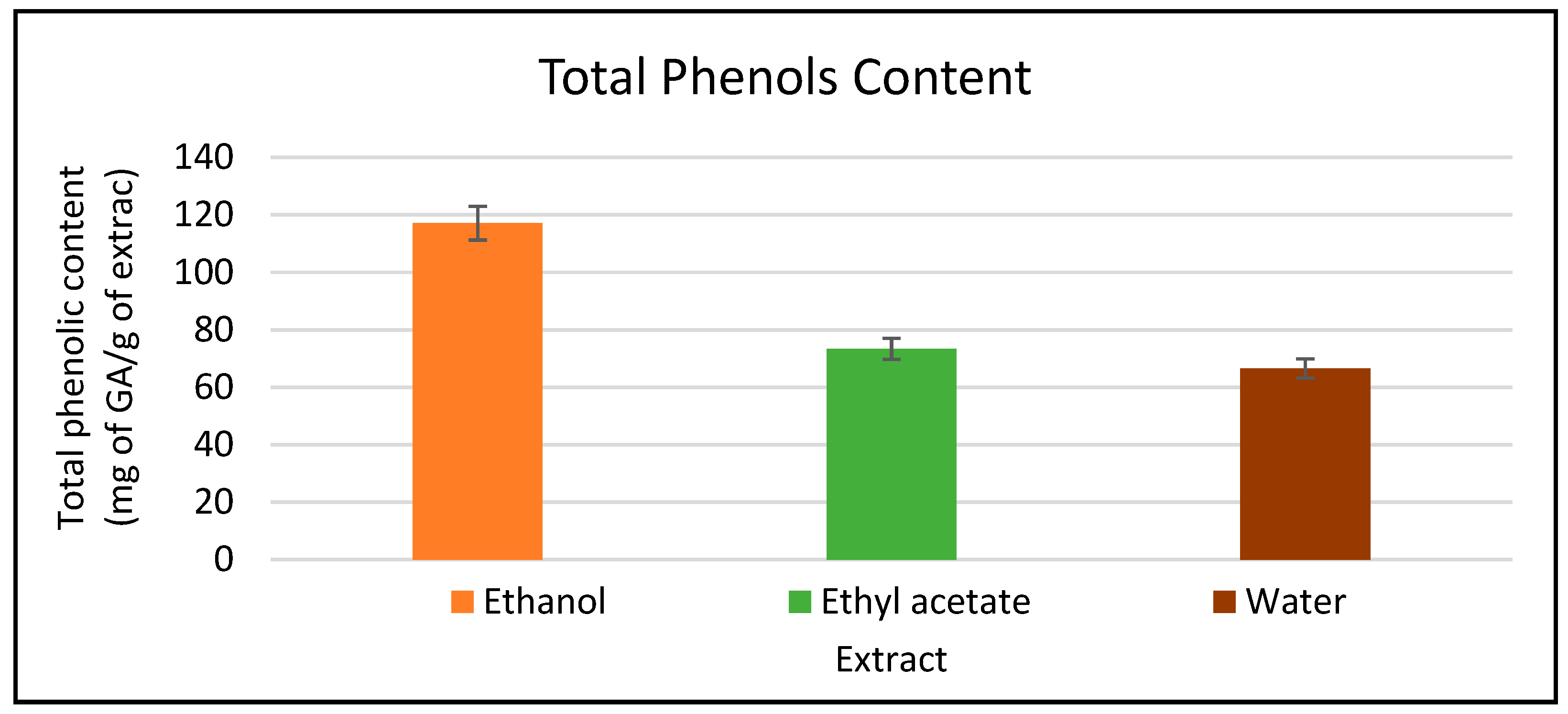
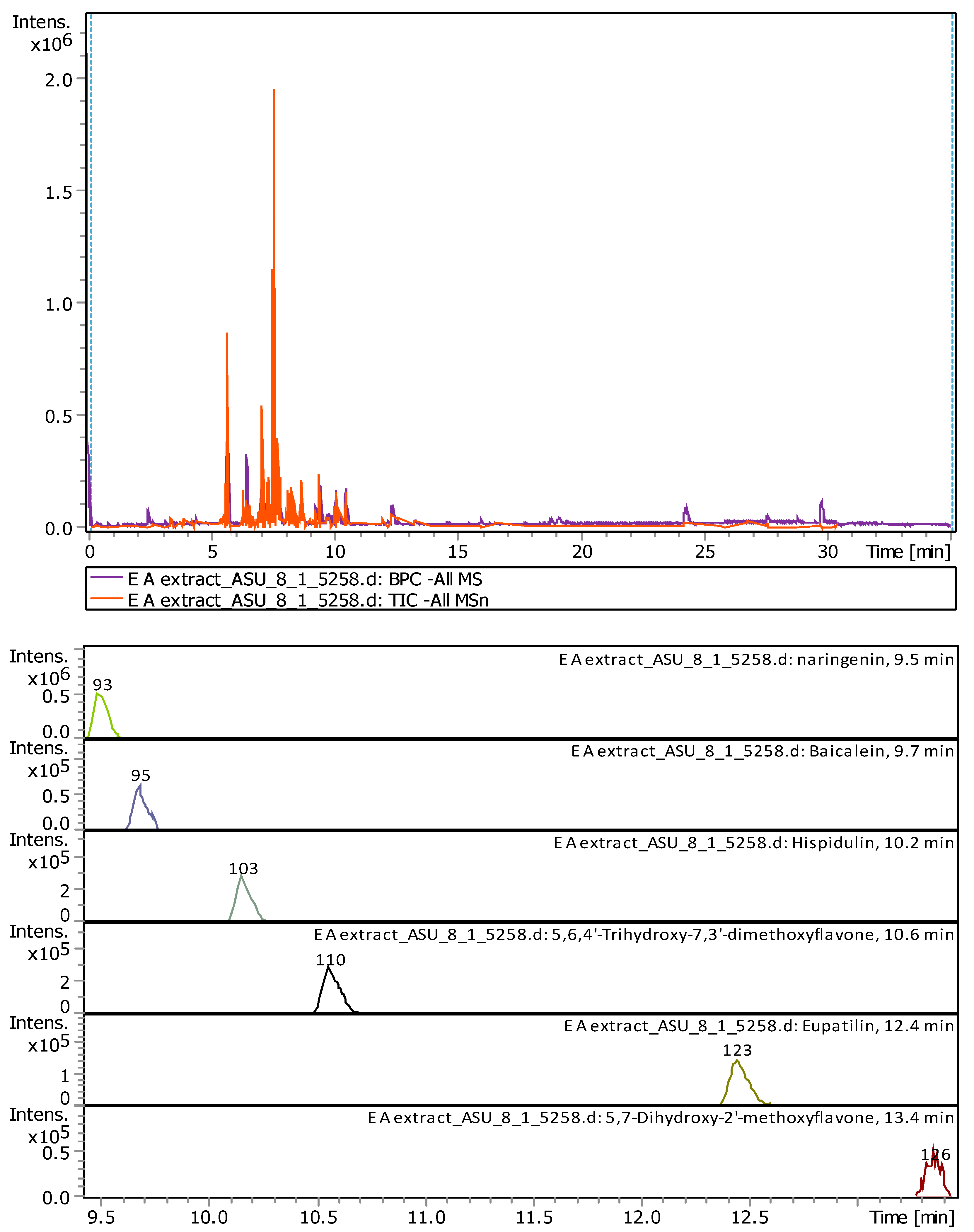
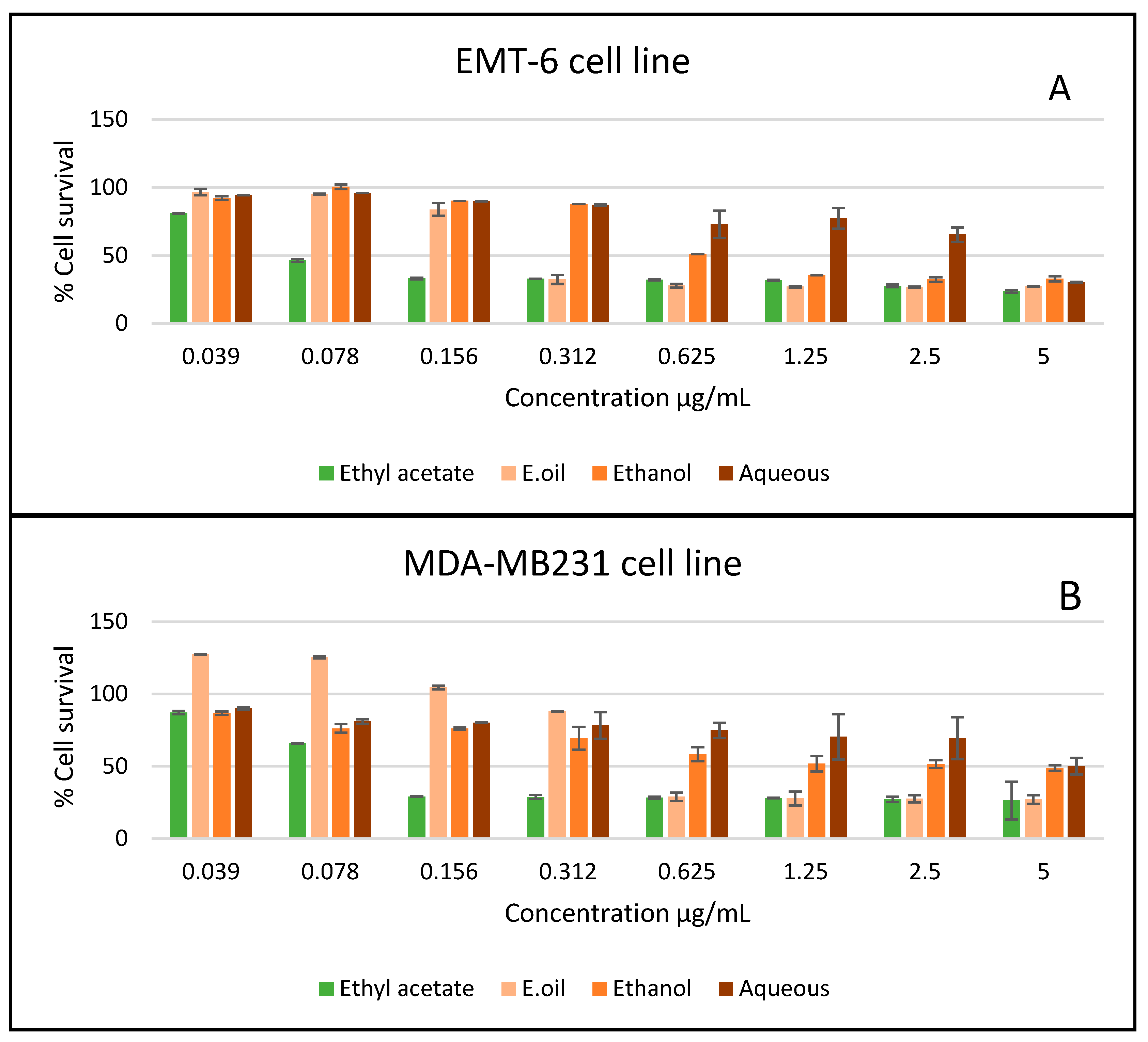

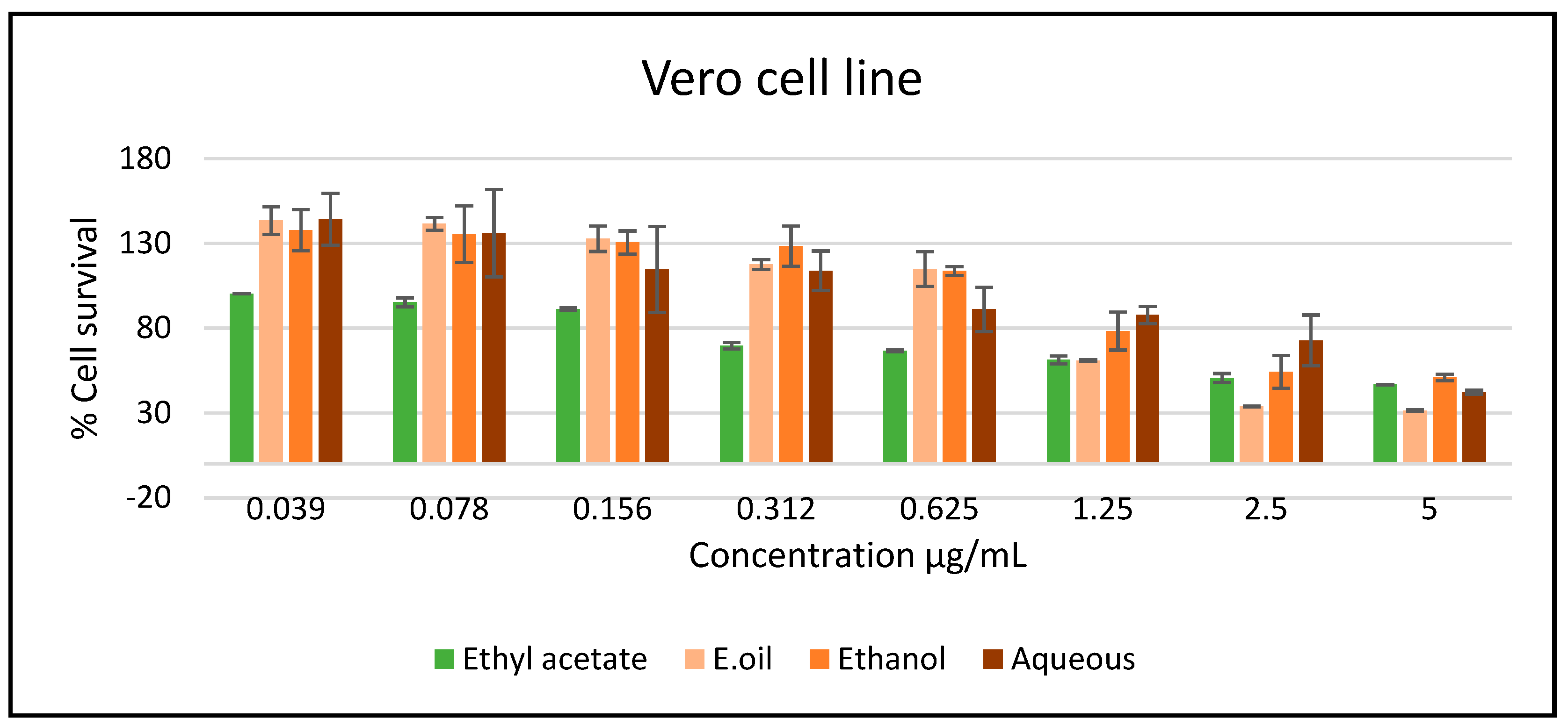
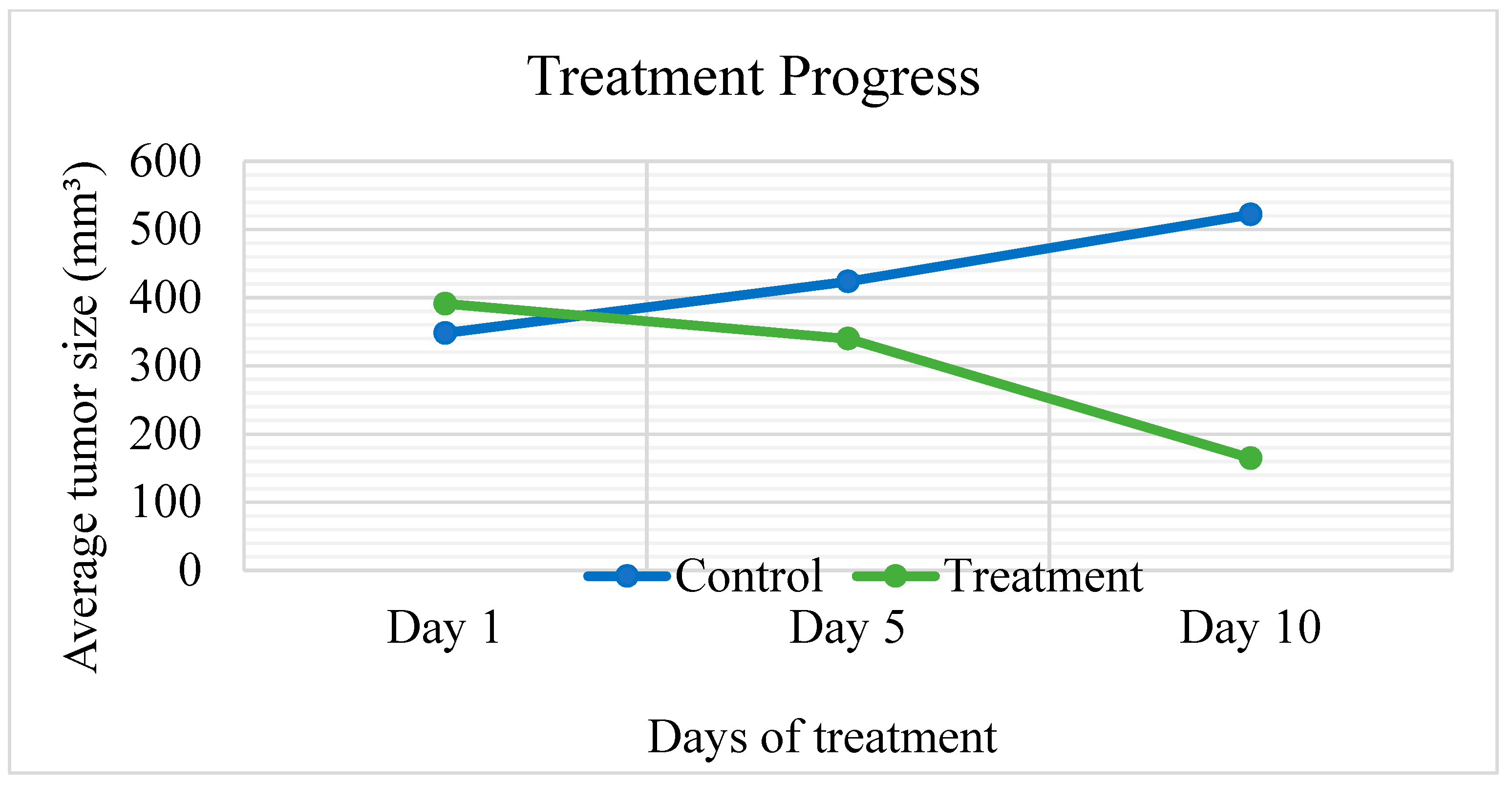
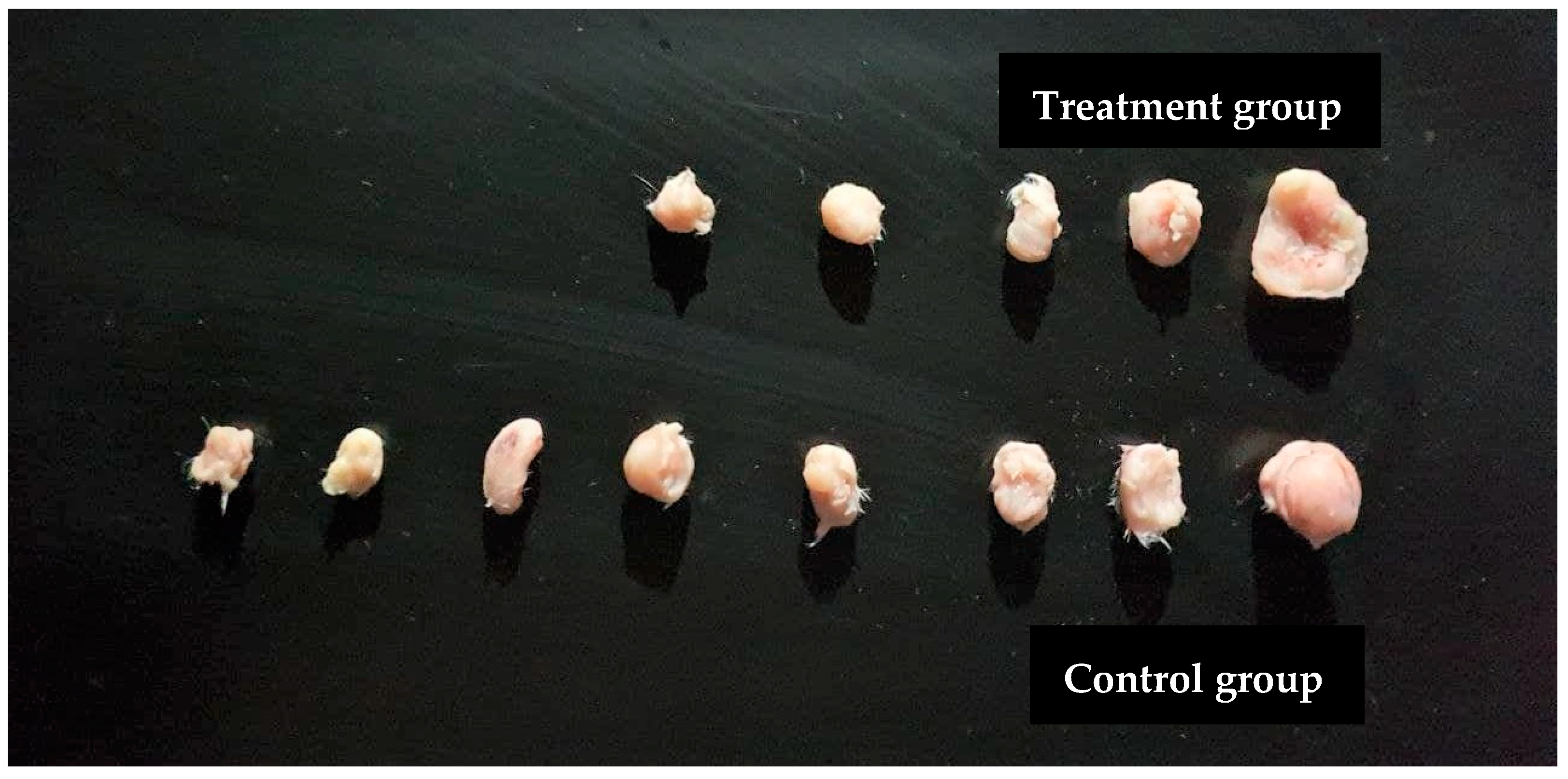
| Extraction Solvent | Yield (w/w%) |
|---|---|
| Water | 5.5% |
| Ethanol | 5.25% |
| Ethyl acetate | 2.3% |
| Essential oil (HD) | 0.25% |
| Name | Molecular Formula | Molecular Wt. | Retention Time | % Of the Identified Compounds |
|---|---|---|---|---|
| Naringenin | C15H12O5 | 272.06834 | 9.5 | 25.22 |
| Baicalein | C15H10O5 | 270.05286 | 9.7 | 7.84 |
| Hispidulin | C16H12O6 | 300.06345 | 10.2 | 22.61 |
| 5,6,4′-Trihydroxy-7,3′-Dimethoxyflavone | C17H14O7 | 330.07387 | 10.6 | 23.67 |
| Eupatilin | C18H16O7 | 344.08932 | 12.4 | 13.24 |
| 5,7-Dihydroxy-2′-Methoxyflavone | C16H12O5 | 284.06833 | 13.4 | 4.91 |
| RI 1 | Compound | HD 2 % | SPME 3 % |
|---|---|---|---|
| 938 | α-Pinene | 0.85 | - |
| 975 | Sabinene | - | 4.00 |
| 974 | β-Pinene | 2.10 | 0.44 |
| 980 | Octanone (3-) | 0.34 | - |
| 986 | Cineol <dehydro-1,8-> | 0.55 | - |
| 991 | Myrecene | 0.20 | - |
| 1032 | d,l-Limonene | 18.80 | 34.40 |
| 1034 | Delta-3-Carene | 0.13 | - |
| 1035 | Cineol <1,8-> | 8.14 | - |
| 1046 | Ocimene <(E)-beta-> | 1.19 | 5.04 |
| 1070 | Sabinene hydrate <cis-> | 0.20 | - |
| 1073 | Mentha-3,8-diene <para-> | 0.39 | - |
| 1099 | Linalool | 0.38 | - |
| 1130 | Allo-ocimene | - | 1.72 |
| 1164 | cis-Chrysanthenol | 0.50 | - |
| 1183 | cis-Pinocarveol | 0.70 | - |
| 1185 | α-Terpineol | 0.65 | - |
| 1196 | Myrtenol | 0.21 | - |
| 1200 | γ-Terpineol | 1.98 | - |
| 1229 | Dihydrocarveol <neoiso-> | 1.90 | - |
| 1240 | trans-Chrysanthenyl acetate | 10.27 | - |
| 1255 | cis-Myrtanol | 1.82 | - |
| 1277 | Verbenyl acetate | 9.10 | - |
| 1296 | Geranyl formate | - | 0.64 |
| 1334 | δ-Elemene | - | 1.74 |
| 1377 | α-Copaene | 1.06 | 4.17 |
| 1380 | Geranyl acetate | 0.42 | - |
| 1385 | β-Cubebene | 0.63 | 1.23 |
| 1403 | α-Longipinene | - | 0.27 |
| 1419 | α-Santalene | 0.89 | 1.25 |
| 1422 | β-Caryophyllene | 5.09 | 16.80 |
| 1427 | β-Copaene | 0.71 | 1.18 |
| 1441 | α-Guaiene | - | 1.35 |
| 1444 | Aromadendrene | - | 0.80 |
| 1448 | Muurola-3,5-diene <cis-> | - | 0.12 |
| 1451 | α-Himachalene | 0.15 | - |
| 1458 | α-Humulene | 0.38 | 0.92 |
| 1460 | α-Patchoulene | 0.95 | 0.17 |
| 1462 | Allo-aromadendrene | - | 2.20 |
| 1471 | β-Acoradiene | 0.44 | 0.92 |
| 1477 | γ-Gurjunene | 0.30 | 1.76 |
| 1483 | γ-Muurolene | 14.13 | 17.25 |
| 1484 | γ-Curcumene | - | 0.21 |
| 1496 | γ-Amorphene | 1.00 | - |
| 1495 | Viridiflorene | - | 0.23 |
| 1498 | Bicyclogermacrene | 2.39 | |
| 1511 | α-Cupranene | - | 0.58 |
| 1515 | γ-Cadinene | 0.36 | 0.20 |
| 1517 | β-Curcumene | 0.20 | |
| 1520 | δ-Cadinene | 0.82 | 0.22 |
| 1563 | Germacrene B | 0.34 | - |
| 1582 | Spathulenol | 3.75 | - |
| 1585 | Caryophyllene oxide | 2.65 | - |
| 1595 | Viridiflorol | 0.20 | - |
| 1647 | α-Muurolol | 0.60 | - |
| Total identified | 97.86 | 99.81 | |
| Terpenoids | 97.52 | 99.81 | |
| Monoterpenes | 60.48 | 46.24 | |
| Monoterpene hydrocarbons | 23.66 | 45.6 | |
| Oxygenated monoterpenes | 36.82 | 0.64 | |
| Sesquiterpenes | 37.04 | 53.57 | |
| Sesquiterpene hydrocarbons | 29.84 | 53.57 | |
| Oxygenated sesquiterpenes | 7.2 | - | |
| Non-terpenoids | 0.34 | - |
| Extract | IC50 mg/mL |
|---|---|
| Water | 49.918 |
| Ethanol | 22.858 |
| Ethyl acetate | 107.044 |
| Hydrodistilled oil | - |
| IC50 (µg/mL) ± SEM | |||||
|---|---|---|---|---|---|
| EMT-6 | MCF-7 | MDA-MB231 | T47D | Vero | |
| Ethyl acetate | 138 ± 20 | 136 ± 13 | 203 ± 60 | 180 ± 40 | 840 ± 160 |
| Essential oil | 410 ± 20 | 540 ± 40 | 633 ± 14 | 402 ± 10 | 1990 ± 100 1 |
| Ethanol | 730 ± 300 | 1510 ± 420 1 | 1240 ± 291 1 | 1076 ± 460 1 | 2510 ± 320 1 |
| Aqueous | 4330 ± 460 1 | 2180 ± 380 1 | 5000 ± 70 1 | 3780 ± 730 1 | 4540 ± 1540 1 |
| SI 1 for the Active A. citrodora Extracts and Essential Oil | |||
|---|---|---|---|
| Ethyl Acetate | Essential Oil | Ethanol | |
| EMT-6 | 6.08 | 4.85 | 3.85 |
| MCF-7 | 6.17 | 3.68 | - 2 |
| MDA-MB231 | 4.13 | 3.14 | - 2 |
| T47D | 4.66 | 4.95 | - 2 |
| Group | Dose g/mL | No. of Mice | No. of Dead Mice | Dose Difference (a) | Mean of Mortality (b) | a∗b |
|---|---|---|---|---|---|---|
| vehicle | control | 6 | 0 | 0 | 0 | 0 |
| 1 | 1.7 | 6 | 2 | 0.1 | 0.5 | 0.05 |
| 2 | 1.8 | 6 | 2 | 0.1 | 1 | 0.1 |
| 3 | 1.9 | 6 | 3 | 0.1 | 1.5 | 0.15 |
| 4 | 2 | 6 | 3 | 0.1 | 2 | 0.2 |
| SUM | 0.5 |
| Av. Initial Tumor Size (mm3) ± SEM | Av. Final Tumor Size (mm3) ± SEM | % Change in Tumor Size | % Of Mice with No Detectable Tumor | Average Tumor Weight (g) | |
|---|---|---|---|---|---|
| Control | 348.12 ± 1.23 | 521.98 ± 0.43 | 49.94 | 11.11 | 443.22 |
| Treatment | 391.14 ± 1.12 1 | 164.38 ± 0.23 | −57.97 2 | 44.44 | 285.33 |
| Group | ALT (IU/L) ± SEM | AST (IU/L) ± SEM | Creatinine (µmol/L) ± SEM |
|---|---|---|---|
| Normal mice | 28.88 ± 9.42 | 119.98 ± 9.42 | 97.24 ± 1.76 |
| Control | 37.21 ± 13.88 | 101.65 ± 10.55 | 106.20 ± 37.88 |
| Treatment | 21.66 ± 7.22 1 | 98.32 ± 27.21 2 | 207.23 ± 113.65 3 |
| GROUP | DOSE |
|---|---|
| Control | Untreated |
| A. citrodora Ethyl acetate extract | (0.16 g/kg/day) IP for 10 days |
Publisher’s Note: MDPI stays neutral with regard to jurisdictional claims in published maps and institutional affiliations. |
© 2022 by the authors. Licensee MDPI, Basel, Switzerland. This article is an open access article distributed under the terms and conditions of the Creative Commons Attribution (CC BY) license (https://creativecommons.org/licenses/by/4.0/).
Share and Cite
Rashid, H.M.; Mahmod, A.I.; Afifi, F.U.; Talib, W.H. Antioxidant and Antiproliferation Activities of Lemon Verbena (Aloysia citrodora): An In Vitro and In Vivo Study. Plants 2022, 11, 785. https://doi.org/10.3390/plants11060785
Rashid HM, Mahmod AI, Afifi FU, Talib WH. Antioxidant and Antiproliferation Activities of Lemon Verbena (Aloysia citrodora): An In Vitro and In Vivo Study. Plants. 2022; 11(6):785. https://doi.org/10.3390/plants11060785
Chicago/Turabian StyleRashid, Hasan M., Asma Ismail Mahmod, Fatma U. Afifi, and Wamidh H. Talib. 2022. "Antioxidant and Antiproliferation Activities of Lemon Verbena (Aloysia citrodora): An In Vitro and In Vivo Study" Plants 11, no. 6: 785. https://doi.org/10.3390/plants11060785
APA StyleRashid, H. M., Mahmod, A. I., Afifi, F. U., & Talib, W. H. (2022). Antioxidant and Antiproliferation Activities of Lemon Verbena (Aloysia citrodora): An In Vitro and In Vivo Study. Plants, 11(6), 785. https://doi.org/10.3390/plants11060785







